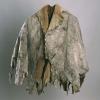Quilt No.191MB - Margaret Bryant

Probably made by George Dennis at Bundalong (VIC), in the 1920s. Owned by George Dennis, then by his daughter Mrs Anne Bryant, then by her daughter Rosa Egan.
Known as The Kangaroo Rug or grampy's Rug. Probably made at Bundalong on the Murray River, Yarrawonga, by George Dennis, using kangaroo pelts from kangaroos shot during hunting trips.
George Dennis (1882-1944)
Mrs Anne Bryant (born Dennis) (1911-1993)
"This rug/quilt was used on beds in my husband's home at Yarrawonga probably following his grandfather's death in 1944 when the said rug/ quilt became something of a family treasure and still is! The maker was a keen shooter, fisherman, and was a farmer by occupation - his wife Isabel Dennis may have helped in quilt making."
[Margaret Bryant]






